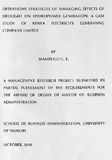| dc.description.abstract | Ansoff (1987) had noted that the business environment was constantly changing and making it imperative for organizations to continuously adapt their activities in order to succeed. To survive in a rapidly changing dynamic environment, organizations needed strategies to focus on their customers and to deal with the emerging environmental challenges. The electric power sector in Kenya had undergone some structural changes since the adoption of Energy Sector Policy Framework Paper (1996-1998) with the unbundling of the hitherto vertically integrated Kenya Power & Lighting Company (KLPC) which was the sole; power generator, transmitter, distributor, and system operator; creation of KenGen and entry of Independent Power Producers (lPPs).
Aosa (1998) had observed that organizations had to constantly adapt their activities and internal configurations to reflect the new external realities and failure to do so might put the future success of the organization in jeopardy KenGen's 70% (749MW) of its power generation was hydropower based and it had faced numerous problems associated with hydrological drought when its capacity dwindled to about 20%. The effects had been tremendously felt by the economy and citizens with prolonged blackouts and expensive replacement emergency power.
The main objectives of the study were to identify; what operations strategies KenGen had put in place to mitigate the effects of drought on hydropower generation and the underlying factors that impacted on management of hydropower generation in KenGen. The study identified that KenGen had put in place strategies to address the effects of drought on hydropower generation among them; the growth strategy focusing on effective delivery of current projects, aggressive expansion of geothermal resource in the next ten years to raise installed capacity to 3,501.5MW by year 2018 and improving capital planning and execution; the regulatory strategy focusing on improving efficiency of the current single-buyer electricity market model through close collaboration with KPLC, KETRACO and ERC, maximizing value for KenGen with tariff restructuring; and the productivity strategy focusing on optimization of existing maintenance practices by implementing planned and CBM programmes, reducing operational and overhead costs in fuel and maintenance work and improving operational effectiveness in procurement of spares.
The study also identified the underlying factors that impacted on management of hydropower generation as; non-implementation of raising of Masinga dam level to increase its capacity, lack of funds, inertia in planning for capacity expansion, environmental and social issues associated with displacement of people, lack of government funding and influence of MOE, KPLC and ERC in deciding the manner in which hydropower plants were dispatched, more so, during hydrological drought periods. | en_US |

